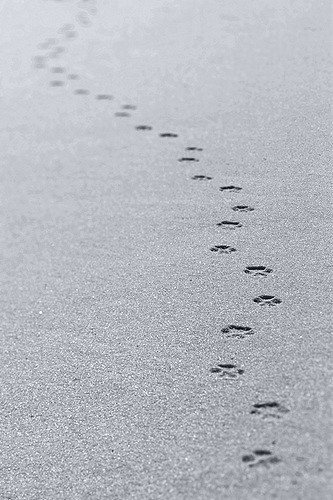by Tom Christopher
Garden wildlife reminds me of teenagers – the critters eat distressingly huge meals then leave without communicating about what they have been up to or where they are going. Except in wintertime, of course, when they (the wildlife, not the teenagers) leave a tale of tracks in the snow.

I’m no great tracker, but with the help of my Peterson Field Guide to Animal Tracks I can at least tell the difference between a fox footprint and that of a dog, trace the travels of the rabbit around my yard, and discover that it’s a porcupine that has been nibbling the branch tips off the hemlocks. There are all sorts of insights to be had from these vestiges. The dog, for example, is likely to wander, sniffing here and there, whereas the fox typically trots in a straight line – one is sure of an ample dinner while the other knows that it cannot afford to waste a single calorie in this harsh season. And by back-tracking the porcupine, I learn what crevice in the rock face across the road it has made into its den. That’s where I’ll set up my have-a-heart trap if the porcupines ravage my vegetable garden again next summer.
It was a string of five-toed footprints, each one not much bigger than a quarter, that told me to keep an eye on the wood pile. And my vigilance was rewarded one gray morning when I spotted a mink darting in between the logs, then re-emerging with a mouse in its jaws.
It’s a thrill to find evidence of such an uncommon (at least in my garden) species, but tracks of the commonest animals excite me just as much if they have a story to tell. A red feather and a spot of blood in a small snow crater told me all I had to know about the encounter of a cardinal and a hawk. And I still remember following across a snowy field next door to our yard the tracks of a Canada goose. Stooping to inspect, I found its toes had dug into the snow and the stride gradually lengthened until, suddenly, the tracks stopped – I, too, felt as if I had taken off.
I have been slower to take up the associated study of animal scat, although my tracking field guide includes diagrams of the droppings with each animal profile. There’s a certain revulsion to be overcome, even though most wild animal droppings, especially those of carnivores, are relatively clean and scent-free. But if I want to know what an animal has been eating, here is where to find out. Below the lone pine at the edge of a forest opening, I’m likely to spot pellets of the barred owl I have been listening to all summer, regurgitated masses of materials that the bird swallowed but could not digest. Pick apart one of these with the tip of my pocketknife and I may find a perfect skull of a mouse or vole. Coyote scat I recognize because it is usually largely composed of hair. Coarse, brown hair tells me that the coyote has been scavenging a deer carcass. Finer, paler hair reveals that it has been hunting snowshoe hares.
One thing is certain: I have to move fast when inspecting tracks on a winter walk. My Duck-Tolling Retriever, Bridie, is usually hot on the trail, too, obliterating the evidence as she pokes her nose into each footprint, so if I don’t get there first, all I find is a series of snow smudges. The visual doesn’t matter to Bridie; she can tell far more from the scent, not only who has been there but when and much more. Indeed, I suspect she regards my failure to put my nose to the ground as the sure mark of a hopeless amateur. Which, of course, is exactly what I am, a tracking semi-literate. But I enjoy the stories even so.













